For those who didn't read my first article, this first set of Type 4 discussions talks about specific house rules and how their implementation can give you a new play experience and fresh options when considering cards to include in your stack.
My first article discussed a few rules and their variants, messing around with what counts as an alternative cost, pretending you have lands in play, and using virtual lands to pay for spell and ability costs.
Moving on, we're going to look at a few more house rules and variants. I strongly suggest you at least take a peek at the previous article, because there's one more thing you should know about rules: They can work in combination. Moving forward, if rules work well in combination, I'll be sure to mention it.
The Restricted Repetitions Law
Repeatable abilities and mechanics can only be used X times per turn.
One of the primary reasons certain cards with nice abilities can become "too good" for T4 is that with infinite mana comes infinite activations. The number of cards that fall under this category is very high, and the power level of a stack is often determined by how many of these infinite-use cards are put in them. Cards like Glarecaster, Glory, Mischievous Quanar, Crown of Convergence, Legacy Weapon, and Johnny, Combo Player are but a few examples of cards that define "near-broken" in T4. And then there are those that are completely broken, which includes creatures that can increase their own power (i.e., "Firebreathers").
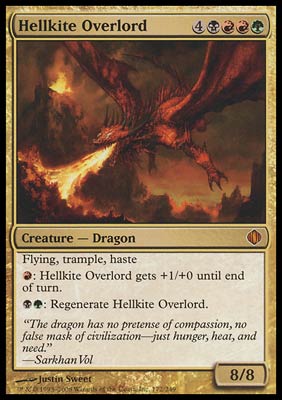
Too powerful? Why? I thought I was such a cool card.
You can solve these issues by limiting the number of times per turn a card can use a particular effect or ability (which usually only applies to abilities or effects that are infinitely repeatable). This not only regulates the power of the more insane cards, but also fixes the totally broken cards so they become fair and usable.
The first thing you have to decide if you use this house rule is how many repetitions of a certain effect are tolerable. If you make the number too high, the effect it has on limiting the power of certain cards isn't too significant, so most groups tend to settle on one to three activations per turn.
You next have to choose to what degree you apply this rule to your game. The most extreme yet cleanest application would be to apply it to all repeatable effects. This way, Legacy Weapon needs more than one turn to annihilate everything, Staff of Domination doesn't go crazy, and those spells with Multikicker or Replicate can't go infinite.
This universal application to all repeatable effects has a few advantages. It leaves your rulebook less cluttered, making it easier for new players to get into a game. It kills the need for individual card errata for many cards people might consider broken, like the common errata among T4 players saying Mischievous Quanar can only copy a given spell once. It even removes the need for that unstated rule of "the defensive ability wins" when faced with an ability war, making Mistmeadow Witch versus Deepfire Elemental conflicts less of a headache (though, as Abe Sargent said, this might lead to a different kind of standoff where people become afraid to activate anything).
The disadvantage of a universal restriction would be that while it's easier to understand and requires less rulebook-keeping, it severely weakens many of the most powerful T4 cards to the point where they're now average, mediocre, or even useless. With only one or two activations per ability, Greater Morphling changes from one of the most powerful T4 creatures to an average (though versatile) beater. Masticore, Vampiric Dragon, and Smokespew Invoker are barely worth using. Combat Medic and Shield of the Ages can't protect anyone. Deathless Angel can only save your other creatures at the expense of its own invulnerability.
A blanket restriction is thus more appealing to weaker T4 stacks, which probably won't have many of the power cards affected by this rule in the first place. Those using this version of the rule should create a stack that values static, triggered, or tap abilities more highly, especially if the activation limit is one per turn instead of two or three (e.g., Linvala, Keeper of Silence instead of Azorius Guildmage).
For something more appealing to the power stacks, look at the following rule variant:
Restricted Repetitions Variant
Repeatable abilities and mechanics that [insert effect(s) here] can only be used X times per turn.
To prevent excessive weakening of certain T4 staples, the more common way of restricting repeatable effects is to only apply it to those effects that the group wants controlled. For example, my group uses this rule: "Repeatable abilities and mechanics that: (1) draw cards, (2) duplicate spells, or (3) increase creature power can only be used twice per turn." This lets most of the power permanents in our stack remain powerful while making cards like Djinn Illuminatus, Stronghold Overseer, and Treasure Trove usable without the burden of adding individual errata for each card (which would be harder to keep track of).
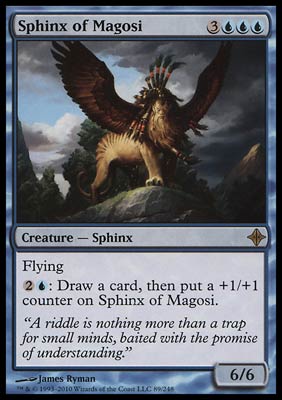
Just try to keep me under control.
To use this rule variation, look at the cards you've considered for your stack that fall under the description of "It could be have been fun if only it weren't so annoying or game-breaking." Gather these cards together and sort them according to effect types to see if there are multiple cards with related effects that you may want to restrict so they can be included in your stack. Remember: Don't make a house rule if it will only affect a single card.
Here is a list of some effect descriptions you may want to consider restricting:
- Drawing cards
- Manipulating/reordering libraries
- Directly destroying permanents
- Damaging players
- Reducing damage to 0
- Copying spells
- Forcing discards
- Milling
- Increasing creature power
- Manipulating cards in the graveyard
- Adding counters
- Creating creature tokens
You can even define repeatable effects by how you pay for them. For example, you can say that "Repeatable abilities and mechanics that are paid for with life can only be used once per turn," to limit the power of both Necropotence and Chainer, Dementia Master. You can even combine this with other rules, such as restricting the power level of the land-manipulation rule variant (the complex variant to the Domain Law house rule I discussed in my previous article).
I'd recommend that you consult your T4 playgroup before you make final decisions and implement this rule variant. Something that you think might be overpowered may be perfectly fine with the majority of your playgroup. For example, to my surprise, repeatable graveyard recursion and destruction abilities are welcomed by most players in my own group. So, we didn't end up restricting those.
More examples of fun cards that can be more viable if ability activations are limited:
- Akroma, Angel of Fury
- Chameleon Colossus
- Geth, Lord of the Vault
- Hellkite Overlord
- Knollspine Invocation
- Mordant Dragon
- Staff of Domination
- Undead Gladiator
The Max X Law
The maximum value of ![]() is equal to [insert number here].
is equal to [insert number here].
This rule was created to allow the use of more spells and abilities with ![]() in their cost, since these cards are normally very dangerous with infinite mana.
in their cost, since these cards are normally very dangerous with infinite mana. ![]() costs were created by Richard Garfield so that certain spell effects could scale with a player's available mana. Infinite mana allows the effects of these spells to scale infinitely, so that cards with
costs were created by Richard Garfield so that certain spell effects could scale with a player's available mana. Infinite mana allows the effects of these spells to scale infinitely, so that cards with ![]() as a cost are by default considered to be too powerful for T4 unless they're individually scrutinized. Make no mistake, while there are many cards with
as a cost are by default considered to be too powerful for T4 unless they're individually scrutinized. Make no mistake, while there are many cards with ![]() costs that are perfectly fair even with
costs that are perfectly fair even with ![]() being unlimited, there are more that become broken.
being unlimited, there are more that become broken.
You could kill the entire table with a single Fireball, pump up a creature's power to infinite levels with Balduvian Rage, or gain infinite life with Who // What // When // Where // Why. This cuts out a huge chunk of otherwise viable cards, especially for newer T4 players who might be having trouble finding Urza's Rage or Searing Wind or other cards that don't need ![]() in their costs.
in their costs.
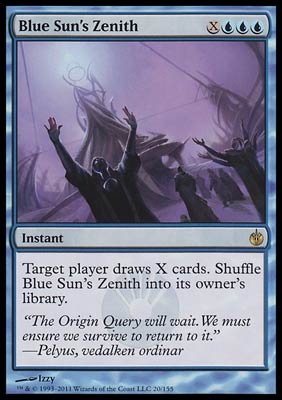
And here I thought you liked drawing cards...
If you limit the value of ![]() , many of those cards are no longer degenerate, and are now safe for T4 play. For simplicity, and because people like round numbers, the favorite values used by playgroups are 10 or 20.
, many of those cards are no longer degenerate, and are now safe for T4 play. For simplicity, and because people like round numbers, the favorite values used by playgroups are 10 or 20.
If you include direct-damage ![]() spells, a good rule to follow is that the maximum value of
spells, a good rule to follow is that the maximum value of ![]() should be no higher than half the maximum life total. So if you're playing with traditional 20-point life totals, don't make
should be no higher than half the maximum life total. So if you're playing with traditional 20-point life totals, don't make ![]() higher than 10.
higher than 10.
The downside to this rule is that while it opens up new card options, it weakens some other ![]() effects to the point where they may no longer be viable, such as the uncommon gems Dwarven Catapult and Hail of Arrows being unusable as "instant Wraths" if
effects to the point where they may no longer be viable, such as the uncommon gems Dwarven Catapult and Hail of Arrows being unusable as "instant Wraths" if ![]() is limited to 10. But it should be fairly easy, if a little more pricy, to find higher-rarity replacements for these. And as a bonus, not only are many of the potential
is limited to 10. But it should be fairly easy, if a little more pricy, to find higher-rarity replacements for these. And as a bonus, not only are many of the potential ![]() replacements powerful, they're a lot of fun as well.
replacements powerful, they're a lot of fun as well.
By combining this rule with the Restricted Repetitions house rule above, even more options become available. For example, limited to one activation per turn, with the highest level of ![]() being 10, some stacks might find Oona, Queen of the Fae, Soothsaying, or Drana, Kalastria Bloodchief to be fair. This rule can even be combined with the Land Cost Law to make cards like Latulla, Keldon Overseer legal for your stack.
being 10, some stacks might find Oona, Queen of the Fae, Soothsaying, or Drana, Kalastria Bloodchief to be fair. This rule can even be combined with the Land Cost Law to make cards like Latulla, Keldon Overseer legal for your stack.
Examples of the many cards now viable if the maximum value of ![]() is limited:
is limited:
- Banefire
- Blazing Shoal
- Brightflame
- Chimeric Staff
- Comet Storm
- Death Grasp
- Flameblast Dragon
- Illuminate
- Lavalanche
- Profane Command
- Riptide Replicator
The Larger than Life Law
Player starting life is [insert number higher than 20].
This is a relatively simple rule with a very simple effect: It prolongs games. The more powerful the stack, and the fewer players there are, the greater the chance of a relatively early win. Some smaller groups simply want their games to last a bit longer. Instead of playing multiple games, there are those who crave the experience of hard-fought, epic battles.
A very simple way to do this is to increase the starting life total to 25, 30, or even 40. The more complex application of this rule alters the starting life total according to how many players there are in total, such as 25 life for five or six players, 30 life for three or four players, and 40 life for those rare instances of a T4 duel.
Those who have played EDH (still easier to say than Commander) already understand what a simple base life total increase can do to lengthen games. But for those who haven't yet experienced the joys of EDH (I can see Robby Rothe shaking his head in disbelief), I'll try to clarify. A higher life total doesn't just mean that you need to hit a player a few more times before he drops. Sure, this means it will take a few more creature attacks to get the job done, but there's more to it than that.
What's more significant is that more life gives you more time to set up your battlefield. At 20 life, I've experienced games where a player was eliminated on the first rotation around the table. He opened up, feeling confident, with a Terra Stomper. Then, a Hasty Spirit of the Night attack from Player 3, an Inferno from Player 6, and a kicked Urza's Rage from Player 7, and it was game over.
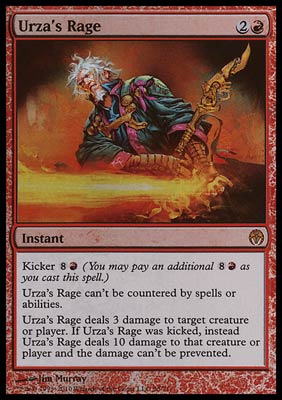
Smashing casual players since the turn of the century.
At 40 life, it's much harder for a person to be eliminated early, so he gets more time to play permanents and set up his board. This leads to more complex board states that you seldom see in normal games, which is a pleasure for those who enjoy a tactical experience.
This is aided by the tendency of many players to try whittling down everyone's life total to what they perceive to be a "manageable level" before concentrating on a single opponent. Even without the political collaboration that is rife in multiplayer games, players tend to pounce on those they deem vulnerable or close to death. A 40-life buffer delays this perception, making players spread out their attacks over different opponents in the early rounds of the game.
While you might think that this environment favors control-oriented players, that's not always the case. The kind of mid- to late-game scenarios you end up with are greatly dependent on what kind of cards you have in your stack. Higher life totals can favor stacks with more creatures, more damage redirection, and more direct damage, rather than those with tons of counter magic and mass removal. Combining high life totals with the Max ![]() rule above helps to fill up the roster of needed damaging cards.
rule above helps to fill up the roster of needed damaging cards.
This rule isn't recommended for larger playgroups. A 40-point life total with a draft pod of seven or eight people can make a single game last a very long time. Hideously long. My group tried it once. The game lasted almost two and a half hours, not counting the draft. And while the grueling battle felt wondrously epic for those who survived for most of that time, for the players who were eliminated fairly early, things got boring quickly, since they had a long period of relative nonparticipation. Even when it was down to the last two players, it still took fifteen minutes for the winner to finish off his opponent. We gladly dropped the life totals back to 20 the next time we played.
To avoid excessively long games, this rule is best applied to playgroups of only three to five players. Also, limit the amount of life-gain cards, or remove them entirely. Set aside the Windbrisk Raptor and Basilisk Collar in favor of cards that use life as a resource, to give players opportunities to spend their life for other things. Cards like the following are excellent in high-life-total games:
- Kuro, Pitlord
- Necrologia
- Necropotence
- Lim-Dul's Vault
- Protective Sphere
- Skeletal Scrying
- Wydwen, the Biting Gale
- Yawgmoth's Bargain
Further, pay closer attention to cards that directly manipulate or ignore life totals. If they're valuable in Commander, they're good in combination with this rule. Consider the following examples:
- Sway of the Stars
- Biorhythm
- Heartless Hidetsugu
- Lich's Mirror
- Skithiryx, the Blight Dragon
- Blightsteel Colossus
- Magister Sphinx
If you're willing to rebuild your stack around this rule, try it out. You might be surprised at how different the game can be.
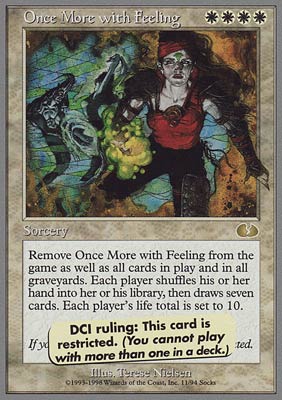
Let's try that again. Only faster.
Once More with Feeling
Yes, there's more to come. And not just about house rules. Meanwhile, if my input above hasn't gotten you thinking, then I leave you with a little card-evaluation exercise to get your mind working.
Bonus Exercise: Let's Draft Type 4
They say that your draft choices say a lot about your playing personality. Let's see how your knowledge and playing style affect your choices. Here's the situation: You're with a playgroup who drafts T4 using simulated randomized fifteen-card boosters (instead of the usual Rochester), and you're drafting the first pack. You've first-picked a Scourge of Kher Ridges in your opening pack, then you get passed these fourteen cards. Which card would you pick as your second card, and why?



















